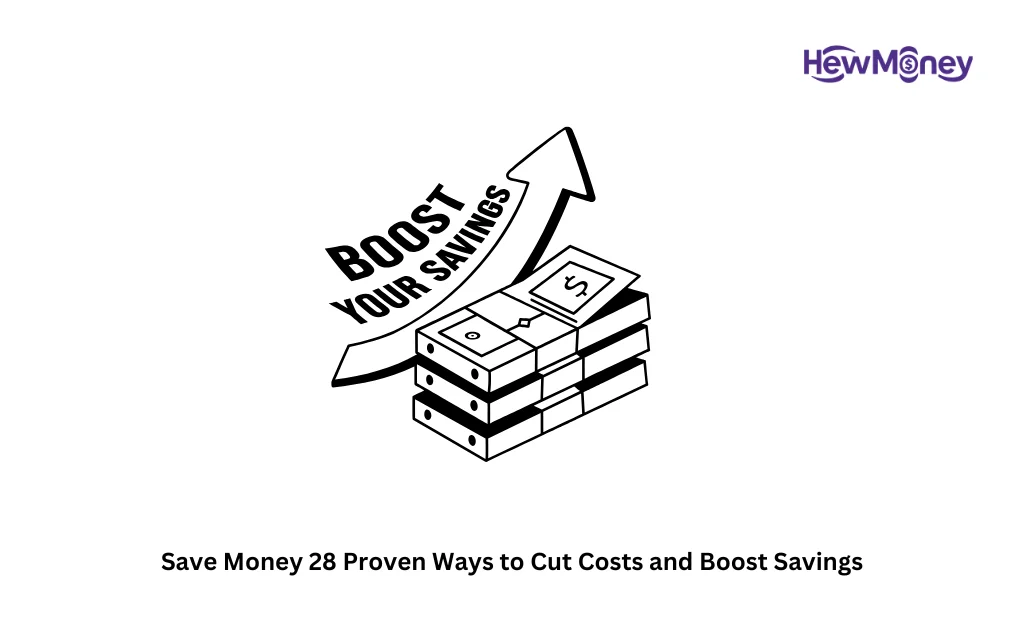Save money by tracking your expenses, making smart purchases, cancelling subscriptions, and using other effective strategies.
Little adjustments can have a big impact on saving money. Here are a few of the most effective techniques to start saving money immediately.
To make it simpler for you to find strategies that will work for you, we have categorized our money-saving advice. For instance, you can reduce your monthly expenses, address your debt, focus on your budget, or try a mix of these tactics.

28 ways to save money
1. Create a budget
Following a budget, which entails comparing your income to your costs and establishing spending priorities, is a wise method to manage your money and, ideally, keep more of it. Start with a piece of scrap paper, a free budget spreadsheet, or our introduction to budgeting.
The 50/30/20 budget is one approach to money management. According to this strategy, you should set aside 50% of your post-tax income for essentials, 30% for wants, and 20% for debt repayment and savings. You can make some changes elsewhere if one of your allocations is higher than these percentages.
It is acceptable if this 50/30/20 breakdown is not appropriate for your financial circumstances. The envelope approach, which involves setting limitations for certain costs, or the 60/30/10 budget would be a better option. Or look into alternative budgeting methods that might be more effective for you.
2. Set savings goals
Regardless of how big or little your aim is, make sure it is clear and achievable. This year, you might want to put $2,000 in an individual retirement account if you have additional money. Perhaps you want to contribute an additional $50 each month to your debt if you are trying to pay it off. Alternatively, saving $5 a week can add up if finances are tight.
To find out how much you would need to save each month or year to meet your goal, use a savings goal calculator.
3. Track spending
Monitor your monthly cash flow, which is the difference between your revenue and expenses. Additionally, this step will make it simpler to track your progress toward your savings target. You can track your expenditures with a variety of budget applications.
4. Count your coins and bills

Putting your spare coins aside every night is an additional choice. Once you have a substantial sum, you can put it into your savings and observe how your account increases. Since it can be more difficult to part with actual cash, it is actually a smart idea to use cash rather than credit cards when you want to keep an eye on your spending. Even though it will not result in savings right away, this method is a good one for gradual growth.
5. Keep savings in a high-yield savings account
Aim to deposit the money you save into a high-yield savings account. Compared to standard options, that kind of account can help your bank balance grow more quickly because it earns an interest rate on deposits that is higher than normal. Study up on the definition of a high-yield savings account.
Learn about second chance checking accounts if your previous banking problems prevent you from being approved for a savings account.
6. Automate transfers
The money will grow over time with minimal effort if you set up monthly recurring transfers from your checking account to your savings account (or through a workplace direct deposit). When your savings accounts are allocated to particular objectives, like creating an emergency fund, paying off debt, taking a trip, or saving for a down payment, this strategy can be quite helpful.
Tackle debt to save on interest

7. Pay off high-interest debt
Your entire budget may be severely strained by debt obligations. You can reduce the overall amount of interest paid and relieve yourself of that burden sooner if you can pay off debt faster. You can do this by making extra payments or by contributing more to the main sum when you can. If you are currently unable to make additional payments, think about looking into side gigs that you could use to pay off your debt.
8. Lower your student loan payments
Since the amount you pay is based on your earnings, if you have student loans, you may be able to reduce your monthly payments to a manageable level by enrolling in income-driven repayment. Additional choices include refinancing student loans, setting up autopay to receive a discount, and making additional payments to pay off the debt more quickly, all of which lower the total amount of interest you pay.
9. Refinance your mortgage
Refinancing your mortgage can save you hundreds of dollars every month if you own a house and can obtain a lower interest rate. However, while determining when to refinance a mortgage, it is crucial to take other considerations into account. Find out how much you may save by using our mortgage refinance calculator. Although there are certain up-front expenses associated with refinancing, these can be recovered over time as your monthly payments decrease.
Cut the cost of monthly bills

10. Prep for grocery shopping
You can save a lot of money on groceries by doing a little research before you go shopping. Make a shopping plan and check your pantry to prevent impulsive purchases of unnecessary items. To receive the most savings when you buy, find out how to obtain coupons and sign up for reward programs.
11. Lower your TV and internet bills
Examine how much you spend on TV and the internet and whether you really need all you are purchasing. For instance, do you watch the premium channels included in your pricey cable package? Do you make use of every streaming service available to you? Do you require the fastest possible internet speeds? Downsizing your cable bundle could result in a monthly savings of up to $40. Other options to think about include lowering your internet package, canceling some streaming services or premium memberships, or getting rid of cable.
In order to retain you as a customer, many internet and cable companies are eager to change their prices. This script can assist you in directing your provider phone call.
12. Switch to a cheaper cell phone plan
To save a significant amount of money, it might be time to switch cell phone plans. You should think about network quality and whether a prepaid or postpaid plan is better for you as you search for the ideal cell phone plan for your circumstances. There is undoubtedly a low-cost cell phone plan that will work for you when you are ready to cut costs.
13. Reduce your electric bill
You can reduce your power cost by making both major and little adjustments to your energy usage. Think about installing smart power strips, replacing your old appliances with more energy-efficient models, installing a smart thermostat, and fixing any insulation gaps in your house. In the long run, even small monthly reductions in your electricity consumption can result in significant savings.
14. Cancel unnecessary subscriptions
It is possible that you are paying for subscriptions that you do not require or use anymore. You can identify any recurrent expenses you can cut by carefully going over your bank or credit card statement. Avoid up for free trials that ask for payment details, or at the very least, remember to cancel before the free time expires by writing down the information or setting a reminder on your calendar.
Save money when you shop

15. Map out major purchases
By planning your purchases of electronics, furniture, cars, appliances, and other items around yearly sales, you can save money. Additionally, you can take advantage of July and October specials that are only available to Amazon Prime members.
It is also worthwhile to monitor prices over time to make sure a deal is indeed a deal. Deal-tracking and couponing can be automated with a shopping browser plugin. For instance, the PayPal Honey addition will automatically locate and apply coupons when you order online, and the Camelizer plugin from Camelcamelcamel makes it simple to view pricing over time on Amazon.
16. Delay purchases with the 30-day rule
Allowing oneself a cooling-off period between the moment an item catches your eye and the actual purchase is one strategy to prevent overspending. You have extra time to determine if you truly need or want the item according to the 30-day guideline. explore adding the item to your online shopping cart and then leaving until you have had more time to explore your options. (In certain situations, when the shop discovers that you left the cart unattended, you may even receive a coupon code.)
You can experiment with shorter wait times, such as 24 or 48 hours, if 30 days feels like too long.
17. Restrict online shopping
Making internet shopping more challenging could help you avoid wasting money on unnecessary items. Choose to enter your delivery address and credit card number each time you place an order rather than storing your billing details. The additional effort required will likely result in fewer impulsive purchases. Even removing any shopping apps from your phone might be something you should think about.
18. Stock up on household supplies when they’re cheap
You may find yourself purchasing toiletries, paper towels, and dish soap on a regular basis. Keep track of the household goods you have on hand and think about purchasing them in bulk during sales. Compared to hurrying to buy them at full price at the last minute, it might be less expensive. Getting regular shipments of home items at a discount can be achieved by using Amazon’s “Subscribe and Save” feature.
19. Shop consignment and thrift stores
One approach to save money is to shop at consignment or thrift stores. Consignment shops allow you to bring in your own items to sell, and both types of stores sell old goods for less than a typical store would.
Make sure you are getting a fair discount by comparing pricing whether you are purchasing from a consignment or thrift store.
20. Get creative with gifts
Affordable gift ideas, such as making art, cooking dinner, or baking cookies, can help you save money. Offering to accompany someone to a nearby (free) museum or other event is another way to give them the gift of your time.
Make a schedule of all the significant gift-giving occasions throughout the year to budget for expenses. After that, establish a savings account just for presents, and purchase the goods at significant sales occasions like Prime Day or Black Friday.
21. Join initiatives to get free items

You can receive anything you need for free thanks to initiatives like Buy Nothing groups and The Freecycle Network. To help the environment and reduce trash, you can swap products locally for free. Additionally, look for these chances on Craigslist, Facebook Marketplace, and Nextdoor.
22. Cash in on your birthday
Set up extra cash once a year by taking advantage of birthday discounts and freebies. Free food or incentives that can be redeemed for clothes could be given to you. We put together a list of dozens of businesses that give away freebies on birthdays.
Spend less money on transportation
23. Lower your car costs
Over the course of your loan, you might save a significant amount of money by refinancing your auto loan and taking advantage of reduced interest rates. Regularly comparing quotes for auto insurance can also help you save money as compared to just letting your current policy renew itself. By avoiding needless quick acceleration, driving less, and eliminating heavy objects from your trunk, you can lower your continuing auto repair expenses.
24. Reduce your gas usage
Although gas prices are beyond your control, there are a number of things you can do to reduce your fuel consumption, such following your car’s maintenance plan and stacking errands to cut down on pointless trips. When you do fill up, try using a gas app to save money.
25. Use car sharing services
If you must rent a car, think about using a car-sharing service like Getaround or Turo as an option. Examine whether car-sharing services end up being less expensive than big, well-known rental companies. It might also be cheaper expensive to use car-sharing services than to own a car or use a cab if you do not drive much.
Find cheaper ways to be entertained

26. Minimize restaurant spending
Given that eating out is typically more expensive than cooking at home, cutting back on restaurant meals is one of the simplest ways to save more money. Try to eat at restaurants less frequently if you still want to, and use whatever restaurant benefits your credit cards may be offering.
To eat out on a budget, you might also choose to share an entree or order appetizers. You can also extend your budget by forgoing beverages and dessert or by indulging in both at home after dinner.
27. Get discounts on entertainment
You may save money on entertainment by taking advantage of free days at national parks and museums. Check your local calendar before spending a lot of money on expensive tickets to private events. Your town may have free concerts and other live or online activities. Additionally, you can inquire about discounts for first responders, students, veterans, senior citizens, and more.
28. Enjoy community events
It can be costly to venture out and try new things. Look through lists at local libraries, places of worship, and websites such as Eventbrite to find free or inexpensive activities. Or use a search engine to locate things to do and type in “events” and your city.
Community events can be a low-cost opportunity for parents to spend quality time with their children and keep them interested. To save money on food, bring water and snacks for outdoor gatherings.

